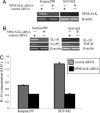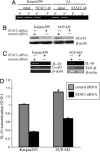Nucleophosmin/anaplastic lymphoma kinase (NPM/ALK) oncoprotein induces the T regulatory cell phenotype by activating STAT3
- PMID: 16766651
- PMCID: PMC1502562
- DOI: 10.1073/pnas.0603507103
Nucleophosmin/anaplastic lymphoma kinase (NPM/ALK) oncoprotein induces the T regulatory cell phenotype by activating STAT3
Abstract
The mechanisms of malignant cell transformation mediated by the oncogenic, chimeric nucleophosmin/anaplastic lymphoma kinase (NPM/ALK) tyrosine kinase remain only partially understood. Here we report that the NPM/ALK-carrying T cell lymphoma (ALK+TCL) cells secrete IL-10 and TGF-beta and express FoxP3, indicating their T regulatory (Treg) cell phenotype. The secreted IL-10 suppresses proliferation of normal immune, CD3/CD28-stimulated peripheral blood mononuclear cells and enhances viability of the ALK+TCL cells. The Treg phenotype of the affected cells is strictly dependent on NPM/ALK expression and function as demonstrated by transfection of the kinase into BaF3 cells and inhibition of its enzymatic activity and expression in ALK+TCL cells. NPM/ALK, in turn, induces the phenotype through activation of its key signal transmitter, signal transducer and activator of transcription 3 (STAT3). These findings identify a mechanism of NPM/ALK-mediated oncogenesis based on induction of the Treg phenotype of the transformed CD4(+) T cells. These results also provide an additional rationale to therapeutically target the chimeric kinase and/or STAT3 in ALK+TCL.
Conflict of interest statement
Conflict of interest statement: No conflicts declared.
Figures






Comment in
-
STAT3: a multifaceted oncogene.Proc Natl Acad Sci U S A. 2006 Jul 5;103(27):10151-10152. doi: 10.1073/pnas.0604042103. Epub 2006 Jun 26. Proc Natl Acad Sci U S A. 2006. PMID: 16801534 Free PMC article. No abstract available.
References
Publication types
MeSH terms
Substances
Grants and funding
LinkOut - more resources
Full Text Sources
Research Materials
Miscellaneous

